View in other NatureServe Network Field Guides
NatureServe
Montana
Utah
Wyoming
Idaho
Wisconsin
British Columbia
South Carolina
Yukon
California
New York
Western Indian Paintbrush - Castilleja occidentalis
Native Species
Global Rank:
G5
State Rank:
S4
(see State Rank Reason below)
C-value:
7
Agency Status
USFWS:
USFS:
BLM:
External Links
State Rank Reason (see State Rank above)
Castilleja occidentalis is quite common in the upper subalpine and alpine zones in vicinity of Glacier National Park within northwest Montana. Disjunct populations are found in Colorado and New Mexico. Many reports from higher elevations in southwest Montana may be from appropriate habitat, but need to be verified. Hybridization or intergradation with other Castilleja species might result in mis-identifications. Threats have not been identified. Current information on locations, populations sizes, and threats are needed from observers that have carefully examined their plants with the appropriate botanical resources.
- Details on Status Ranking and Review
Range Extent
ScoreF - 20,000-200,000 sq km (~8,000-80,000 sq mi)
Comment68,638 square kilometers
Area of Occupancy
ScoreD - 6-25 4-km2 grid cells
CommentPlant occurs in 24 of the 30,590 4x4 square-kilometer grid cells that cover Montana.
Number of Populations
ScoreC - 21 - 80
Comment44 observations
Environmental Specificity
ScoreC - Moderate. Generalist or community with some key requirements scarce
Threats
ScoreD - Low
General Description
PLANTS: A short, hemi-parasitic, herbaceous perennial plant that arises from a branched caudex. Plants grow 5-20 cm tall and are multi-stemmed. Foliage is green with short hairs (glabrate to puberulent).
LEAVES: Arranged alternately on the stem. Leaves are green (occasionally reddish at base), narrowly lanceolate, 1–3 cm long, and usually entire along the margins. The lowest leaves are smallest. Leaves generally feature prominent veins and a puberulent surface.
INFLORESCENCE A dense, terminal, bracteate spike, usually less than 4 cm long. The inflorescence is viscid-villous. Bracts are yellowish-white to green, sometimes purplish-tipped, narrowly ovate, entire or with a pair of small lateral lobes. The calyx is 15–23 mm long with subequal primary clefts and rounded ultimate lobes of 1–3 mm long. The corolla is whitish, 18–25 mm long with the galea 5–9 mm long and the lower lip 2–4 mm long.
Sources: Giblin et al. [eds.] 2018; Lesica et al. 2012; Holmgren in Intermountain Flora 1984.
Diagnostic Characteristics
Castilleja is a difficult genus because hybridization and allopolyploid speciation (containment of multiple sets of chromosomes that are derived from different species) fuzz a species’ characteristics (Giblin et al. [eds.] 2018).
To identify
Castilleja species, it is important to (Giblin et al. [eds.] 2018):
* note colors of the bract, calyx, and corolla while in the field, and
* press many bracts, calyces, and corollas separately to show their shapes.
Western Indian Paintbrush -
Castilleja occidentalis, native:
Hybridizes with
Castilleja rhexifolia resulting in flowers colored from white to purple (Lesica et al. 2012). In Alberta Canada, plants intergrade with
Castilleja sulphurea (Moss and Packer 1983).
* Plants short, 10-20 cm tall.
* Bracts are yellow-white to green, sometimes purple-tipped.
* Upper third of the stem with green, mostly entire, non-lobed leaves.
* Uppermost leaves narrowly lanceolate.
* Inflorescence with viscid-villous hairs.
* Montana plants occur in upper subalpine to alpine zones.
Rhexia-leaf Indian Paintbrush -
Castilleja rhexifolia, native:
* Bracts are reddish-purple.
* Corolla green to red.
* Upper stem with green, entire, non-lobed leaves (except sometimes the uppermost).
* Primary clefts of the calyx are about equal.
* Galea is 8-12 mm. Lower corolla lip is 1-4 mm.
* Inflorescence with viscid-villous hairs.
* Montana plants occur in subalpine to alpine zones.
Sulphur Indian Paintbrush -
Castilleja sulphurea, native:
* Bracts and corolla are yellow.
* Foliage is glabrous to puberulent
* Primary clefts of the calyx are slightly deeper adjacent to the corolla lip than compared to the back.
* Galea is 6-10 mm. Lower corolla lip is 1-3 mm.
* Inflorescence with glandular-villous hairs.
* Montana plants occur in valleys to subalpine zones.
Species Range
Montana Range
Range Descriptions
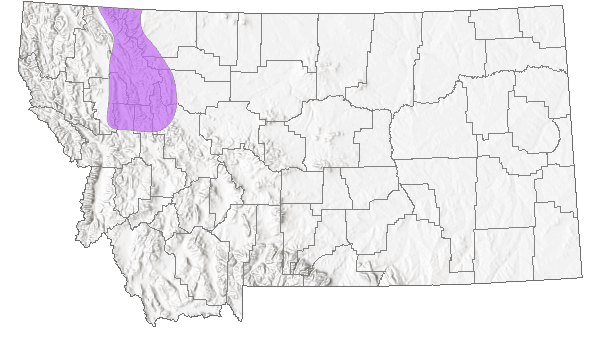
 Native
Native
Range Comments
British Columbia and Alberta south to Utah and New Mexico (Lesica et al. 2012).
Observations in Montana Natural Heritage Program Database
Number of Observations: 78
(Click on the following maps and charts to see full sized version)
Map Help and Descriptions
Relative Density
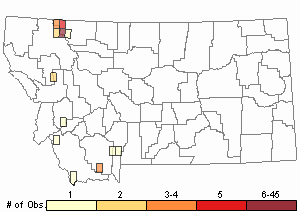
Recency
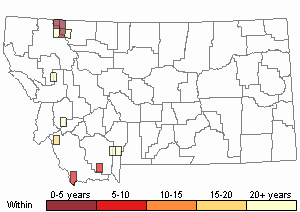
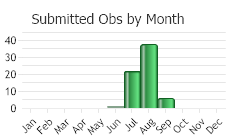
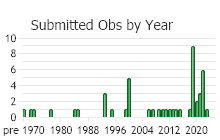
 (Observations spanning multiple months or years are excluded from time charts)
(Observations spanning multiple months or years are excluded from time charts)
Habitat
Moist meadows and moraine in the upper subalpine and alpine zones in Montana (Lesica et al. 2012).
Ecology
POLLINATORS The following animal species have been reported as pollinators of this plant species or its genus where their geographic ranges overlap:
Bombus appositus,
Bombus bifarius,
Bombus fervidus,
Bombus flavifrons,
Bombus melanopygus,
Bombus sylvicola,
Bombus occidentalis, and
Bombus kirbiellus (Macior 1974, Thorp et al. 1983, Bauer 1983, Mayer et al. 2000, Wilson et al. 2010, Pyke et al. 2012, Koch et al. 2012, Miller-Struttmann and Galen 2014, Williams et al. 2014).
Stewardship Responsibility
References
- Literature Cited AboveLegend:
 View Online Publication
View Online Publication Bauer, P.J. 1983. Bumblebee pollination relationships on the Beartooth Plateau tundra of Southern Montana. American Journal of Botany. 70(1): 134-144.
Bauer, P.J. 1983. Bumblebee pollination relationships on the Beartooth Plateau tundra of Southern Montana. American Journal of Botany. 70(1): 134-144. Cronquist, A., A.H. Holmgren, N.H. Holmgren, J.L. Reveal, and P.K. Holmgren. 1984. Intermountain Flora: Vascular Plants of the Intermountain West, U.S.A. Vol. 4, Subclass Asteridae (except Asteraceae). Bronx, NY: New York Botanical Garden. 573 pp.
Cronquist, A., A.H. Holmgren, N.H. Holmgren, J.L. Reveal, and P.K. Holmgren. 1984. Intermountain Flora: Vascular Plants of the Intermountain West, U.S.A. Vol. 4, Subclass Asteridae (except Asteraceae). Bronx, NY: New York Botanical Garden. 573 pp. Hitchcock, C.L. and A. Cronquist. 2018. Flora of the Pacific Northwest: An Illustrated Manual. Second Edition. Giblin, D.E., B.S. Legler, P.F. Zika, and R.G. Olmstead (eds). Seattle, WA: University of Washington Press in Association with Burke Museum of Natural History and Culture. 882 p.
Hitchcock, C.L. and A. Cronquist. 2018. Flora of the Pacific Northwest: An Illustrated Manual. Second Edition. Giblin, D.E., B.S. Legler, P.F. Zika, and R.G. Olmstead (eds). Seattle, WA: University of Washington Press in Association with Burke Museum of Natural History and Culture. 882 p. Koch, J., J. Strange, and P. Williams. 2012. Bumble bees of the western United States. Washington, DC: USDA Forest Service, Pollinator Partnership. 143 p.
Koch, J., J. Strange, and P. Williams. 2012. Bumble bees of the western United States. Washington, DC: USDA Forest Service, Pollinator Partnership. 143 p. Lesica, P., M.T. Lavin, and P.F. Stickney. 2012. Manual of Montana Vascular Plants. Fort Worth, TX: BRIT Press. viii + 771 p.
Lesica, P., M.T. Lavin, and P.F. Stickney. 2012. Manual of Montana Vascular Plants. Fort Worth, TX: BRIT Press. viii + 771 p. Macior, L.M. 1974. Pollination ecology of the Front Range of the Colorado Rocky Mountains. Melanderia 15: 1-59.
Macior, L.M. 1974. Pollination ecology of the Front Range of the Colorado Rocky Mountains. Melanderia 15: 1-59. Mayer, D.F., E.R. Miliczky, B.F. Finnigan, and C.A. Johnson. 2000. The bee fauna (Hymenoptera: Apoidea) of southeastern Washington. Journal of the Entomological Society of British Columbia 97: 25-31.
Mayer, D.F., E.R. Miliczky, B.F. Finnigan, and C.A. Johnson. 2000. The bee fauna (Hymenoptera: Apoidea) of southeastern Washington. Journal of the Entomological Society of British Columbia 97: 25-31. Miller-Struttmann, N.E. and C. Galen. 2014. High-altitude multi-taskers: bumble bee food plant use broadens along an altitudinal productivity gradient. Oecologia 176:1033-1045.
Miller-Struttmann, N.E. and C. Galen. 2014. High-altitude multi-taskers: bumble bee food plant use broadens along an altitudinal productivity gradient. Oecologia 176:1033-1045. Moss, E. H. and J. G. Packer. 1983. Flora of Alberta. 2nd edition revised by J. G. Packer. University of Toronto Press, Toronto, Ontario, Canada. 687 pp.
Moss, E. H. and J. G. Packer. 1983. Flora of Alberta. 2nd edition revised by J. G. Packer. University of Toronto Press, Toronto, Ontario, Canada. 687 pp. Pyke, G.H., D.W. Inouye, and J.D. Thomson. 2012. Local geographic distributions of bumble bees near Crested Butte, Colorado: competition and community structure revisited. Environmental Entomology 41(6): 1332-1349.
Pyke, G.H., D.W. Inouye, and J.D. Thomson. 2012. Local geographic distributions of bumble bees near Crested Butte, Colorado: competition and community structure revisited. Environmental Entomology 41(6): 1332-1349. Thorp, R.W., D.S. Horning, and L.L. Dunning. 1983. Bumble bees and cuckoo bumble bees of California (Hymenoptera: Apidae). Bulletin of the California Insect Survey 23:1-79.
Thorp, R.W., D.S. Horning, and L.L. Dunning. 1983. Bumble bees and cuckoo bumble bees of California (Hymenoptera: Apidae). Bulletin of the California Insect Survey 23:1-79. Williams, P., R. Thorp, L. Richardson, and S. Colla. 2014. Bumble Bees of North America. Princeton, NJ: Princeton University Press. 208 p.
Williams, P., R. Thorp, L. Richardson, and S. Colla. 2014. Bumble Bees of North America. Princeton, NJ: Princeton University Press. 208 p. Wilson, J.S., L.E. Wilson, L.D. Loftis, and T. Griswold. 2010. The montane bee fauna of north central Washington, USA, with floral associations. Western North American Naturalist 70(2): 198-207.
Wilson, J.S., L.E. Wilson, L.D. Loftis, and T. Griswold. 2010. The montane bee fauna of north central Washington, USA, with floral associations. Western North American Naturalist 70(2): 198-207.
- Additional ReferencesLegend:
 View Online Publication
View Online Publication
Do you know of a citation we're missing? Hawkins, P.H. 1903. The alpine flora of Montana. M.Sc. Thesis, Bozeman, MT: Montana State University. 24 pp.
Hawkins, P.H. 1903. The alpine flora of Montana. M.Sc. Thesis, Bozeman, MT: Montana State University. 24 pp. Lesica, P., M.T. Lavin, and P.F. Stickney. 2022. Manual of Montana Vascular Plants, Second Edition. Fort Worth, TX: BRIT Press. viii + 779 p.
Lesica, P., M.T. Lavin, and P.F. Stickney. 2022. Manual of Montana Vascular Plants, Second Edition. Fort Worth, TX: BRIT Press. viii + 779 p.
- Web Search Engines for Articles on "Western Indian Paintbrush"





